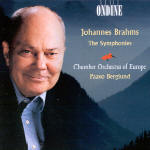Paavo Berglund’s use of a chamber orchestra in this music elicits an obvious comparison to Charles Mackerras’ excellent Telarc Brahms cycle, but the similarities end there. Mackerras’ performances employ the entire gamut of period instrument interpretive options, from string portamento to wide fluctuations in tempo. Berglund’s intention, as it was with his recent Sibelius cycle with the same forces, seems simply to achieve an unprecedented degree of instrumental transparency at all dynamic levels, and in this he’s completely successful. Whether this tactic best serves the music is another matter.
Berglund’s pursuit of textural clarity at all costs has three principal effects: (1) it uncovers a wealth of detail, particularly in lower strings and winds; (2) it tends to place melody and accompaniment on the same plane, producing a strikingly “two-dimensional” effect; (3) for better or for worse, it emphasizes the obviously pianistic origins of much of Brahms’ orchestral writing. An excellent example of this occurs at the opening of the Fourth Symphony. Instead of a clear principal melody borne aloft on a cushiony accompaniment of strings and winds, the tune threads its way through a thicket of figurations of different shapes and sizes.
On the whole, Berglund’s approach works best in slow movements and scherzos (that of the Fourth Symphony is particularly bright and fresh), places such as the first movement of the Third Symphony where the thickness of the orchestration poses real problems of articulation and rhythmic clarity, and in the less obviously dramatic sonata movements (the Second Symphony’s opening). But in those rare but critical moments when Brahms really stokes the fires (outer movements of the First Symphony, finales of the Third and Fourth Symphonies), Berglund’s vision obstinately fails to allow the music the necessary room to expand into its climaxes. The result, despite generally swift tempos and incisive rhythms, seriously lacks energy. Thrilling moments such as the lead-in to the First Symphony’s first movement recapitulation, or the massive climax at the center of the Third Symphony’s finale, pass by leaving little impression at all.
Obviously, this is exactly what Berglund intended. As a realization of his “concept”, these renditions offer superb playing and very good sound that supports the approach without turning the performances into vivisections. This isn’t “cold” playing or conducting at all; nor is it fussy, mannered, or otherwise inhibited. Berglund conducts in large musical paragraphs, not short-breathed phrases, and his approach often permits a striking degree of melodic continuity even when–or perhaps because–he underplays the more dramatic or disruptive passages (listen, for example, to the way in which he binds together the variously calm and agitated episodes that comprise the Fourth Symphony’s first movement development section).
Anyone looking for a successfully radical take on the music would probably do better with these performances than with either Mackerras or, say, Harnoncourt. Still, Berglund’s conception of Brahms, however well realized, reveals far less of the music’s expressive potential than many other versions, including the two just mentioned. He’s interesting, sometimes very much so, but little more; and this bears directly on whether or not you will want to repeat the experience often enough to justify purchase of this complete set. It’s your call.
































